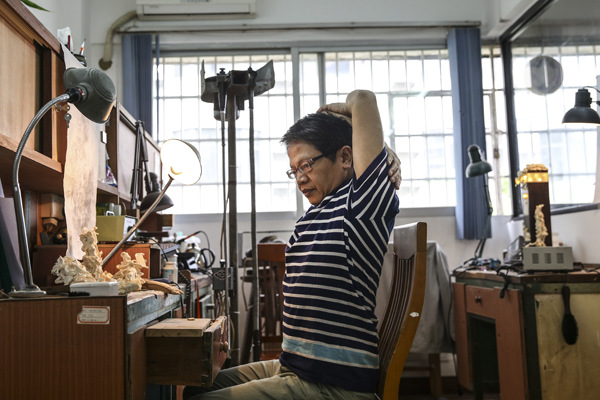
A member of staff at work at the Guangzhou Daxin Ivory Carving Factory. (Photo by Zou Hong/China Daily)
"Leaving aside the question of the future, if no policy is devised to save this dying art, it may be impossible to repair ancient art works in a few decades," said Geng Boling, who has practiced ivory carving for 46 years, and has worked as a repairer of artifacts at the Palace Museum in Beijing since 2014.
In the past three years, Geng has repaired ivory pieces from the Ming (1368-1644) and Qing dynasties (1644-1911). "That's the highest level of artistic achievement - the acme of perfection," he said.
However, a lack of elephant tusks and the loss of a number of traditional skills means the repair of large artifacts has been suspended indefinitely. Every time he looks at masterpieces made hundreds of years ago, Geng envies the old masters who devoted their entire lives to the craft.
"Life is not a fairy tale where all dreams come true," he said. At 63, he is no longer concerned about whether his skills will feed his family, so he has chosen to accept that ivory carving is doomed.
"For the development of society, it's just one of thousands of ways of earning a living and is relevant to very few people," he said. While he agrees that elephants should be protected, Geng doesn't want to see all ivory outlawed.
Exploitation and extinction
"Overexploitation of ivory will result in elephants becoming extinct, but artists should be allowed to use ivory from elephants who have died of natural causes, and pass their skills and experience onto the next generation," he said.
Even if the use of ivory were outlawed completely, the artisans could still work with jade, wood, bull's bones and even mammoth tusks, but few would make the choice.
Zhang, the factory director, said ivory has perfect hardness, somewhere between wood and jade, which makes almost all shapes, such as tiny petals and leaves possible. It can even be fashioned into stripes as thin as instrument strings.
The best illustration of ivory's unique nature is a sleeping mat used by the Empress Dowager Cixi of the Qing Dynasty, which was woven from very thin, soft strips of ivory and is as flexible as wicker, according to Zhang.
Other materials, such as bull's bones have limitations in terms of size and shape, so they can only be used for small, simple works.
"Mammoth ivory, the only legal material with a texture similar to elephant ivory, is the best choice. But it's no cheaper, and the amount available is very limited," she said.
Now, only 35 artisans work at the Guangzhou Daxin Ivory Carving Factory in Guangdong province - China's only State-owned ivory facility - but in the 1960s, about 600 people were employed in the company's workshops.
The factory's name, Daxin, is also the name of a street in the center of Guangzhou, Guangdong province, which was famous as the epicenter of the ivory trade during the Qing Dynasty.
Founded in 1955, the factory once had three shops in the street. Years ago, it moved to an old three-story building in a suburb. Many of the carvers left - some moved into other industries, while the rest learned to work with bone or wood, which were far less lucrative trades.
Zhang Minhui, who joined Daxin in 1972 at age 19, is one of the few carvers who enjoyed success after leaving the factory. He now runs his own workshop called the Flower City Boya Craftwork Factory.
Honored as a Guangdong ivory carving master and a National Inheritor of Intangible Cultural Heritage, Zhang Minhui is not only an active artist, he is also passionate about social activities. About 15 titles are printed on his name card, including chairman of the Guangzhou Folk Artists Association and deputy director of the Guangdong Arts and Crafts Association.
His workshop employs about 20 artisans, who work with ivory, bull's bones and mammoth tusks. He only keeps a small stock of ivory, so when that is exhausted, his employees will mainly work with other materials.
"It's not the best option, but it's better than no option. Most experienced craftsmen are age 60 or older and they aren't concerned about losing their jobs. However, the real concern is the fate of ivory carving as an art. It would be a sad loss," he said.


















































